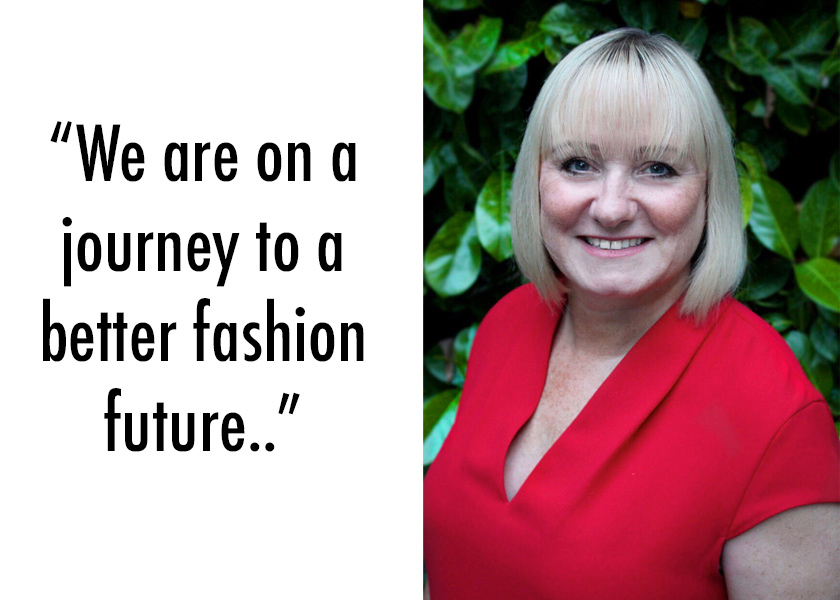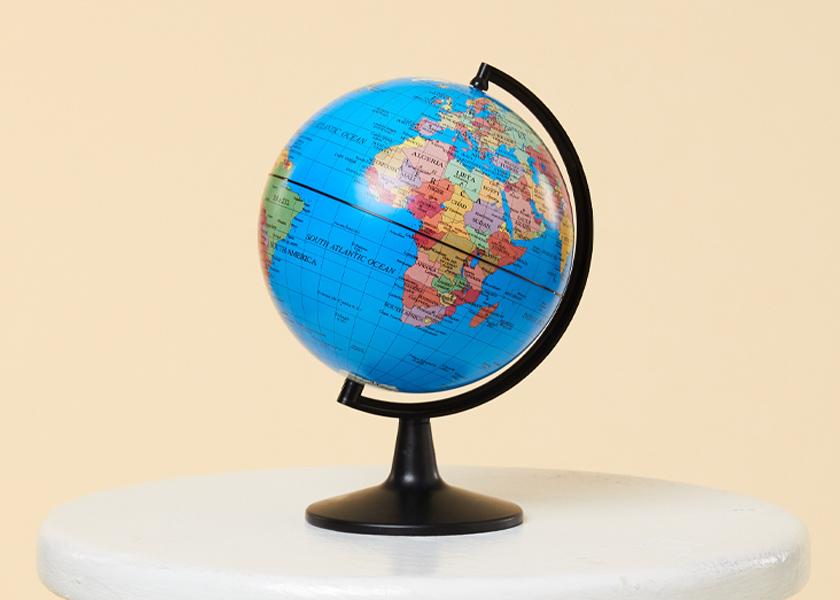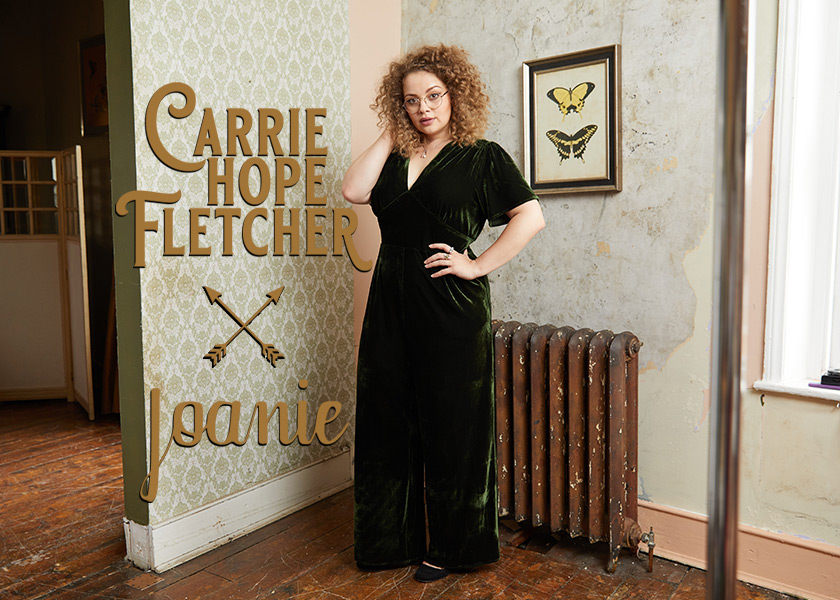We’re committed to sustainability! Last year, we prioritised making steps to become more sustainable and a big part of this was to hire an expert Sourcing & Sustainability Consultant to help us develop new processes and become more accountable for our environmental footprint, introducing Julia Redman! Read on to learn more about our work with Julia and the steps we’re taking on our sustainability journey.
You may have noticed our new Sustainability page on the website, alongside new products created with sustainable fabrics. We listen to our Joanie Gals, our customers and our consciences, and as a result, we have pledged to put more focus on sustainability in all that we do. By the end of this year we hope to have over 50% of Joanie’s products made from sustainable fabrics, with a greater target for 2022.
Sustainability in fashion is somewhat of a hot topic and it can be tricky as a customer to navigate the claims, jargon and diverse initiatives being adopted by different brands. Our aim is to be as transparent as possible with our customers about our journey, so we’ve added lots of information to our new Sustainability page, created a category containing our sustainable styles for easy shopping and marked these pieces with ‘Sustainable Fabric’ labels on the website – you’ll find more information about these fabrics on product pages too.
Our Sourcing & Sustainability Consultant, Julia Redman
We’ve learnt a lot from our Sourcing & Sustainability Consultant, Julia and thought you’d love to know more about her too! A Fashion Buying supremo, we talk to Julia about her career in the fashion industry and what her role with Joanie entails. With over 30 years’ experience in retail buying and sourcing, Julia has experienced the extreme highs and lows of a career in the rag trade, and everything else it’s had to throw at her!
Julia joined the Joanie team in 2020 as our expert Sourcing & Sustainability consultant. Her buyer’s eye and experience are helping our brand along on our mission to becoming more a sustainable business.

Hi Julia, how you did you get into this interesting profession?
I was always very interested in fashion and retail, so I did a degree in Food, Textile and Consumer Studies before landing my first, very unglamorous role, as an allocator at BHS, manually allocating stock by colour and size of each product to every single store – a job that these days is done with modern technology and algorithms! After that, I switched to buying and worked my way up, moving on as a Buyer for Arcadia (Burton and Topman) and then at Woolworths, Debenhams, Marks and Spencer and eventually Head of Buying at M&Co. I now work with retailers and suppliers who want to improve their sustainable credentials, as well as teaching sustainable buying and sourcing skills to university students.
What does a Buyer do? Is it just shopping?
A very limited part of the Buyer’s role is about shopping. For example, at the beginning of researching a new season, buyers might spend a lot of time out in the shops in various parts of the world, looking for inspiration but even then, it is not really about shopping, it is about getting inside your customers head and understanding what they might be looking for 6 months or more down the line. Being able to understand and interpret trends in style and colour, adapting them and working with your designers to develop product that your customers will want to buy.
It definitely changes the way you shop. Understanding what goes into the creation of a garment, the costs and the people involved in getting that garment from concept to store, makes you far more considered, as a shopper. I would rather buy nothing at all than something that has been made cheaply, and potentially unsustainably or unethically.
Where in the world has your career taken you – and what experiences have made the most impact on you?
I have been incredibly lucky to have travelled all over the world as a Buyer, from the shopping trips to New York, LA, Paris, Amsterdam, Antwerp, Milan, Florence and Seoul, and into the factories in India, Bangladesh, China, Indonesia, Turkey, Romania, Cambodia and Sri Lanka. I love to travel, although I am becoming very conscious of my impact on the environment when I do, and every trip is an education.
Most memorable moments? Visiting the first carbon neutral factory in the world in Sri Lanka, almost 10 years ago. This was instrumental in developing my understanding and passion for sustainable sourcing. Also in Sri Lanka, having had the opportunity on a rare afternoon off, to see wild elephants at a vast nature reserve, an experience that will live with me forever! And one that reminds me that it is our responsibility, as human beings, to do everything we can to preserve our wildlife and its habitats. I’ve also had some fairly hair-raising moments, on one particular occasion having to be rushed to the airport in Dhaka as it was becoming less and less safe to be there due to civil unrest at the time. I have, on occasion, cancelled trips because of safety concerns. At all times, the safety and security of my team has been my utmost priority.
No trip to places like this ever goes completely according to plan and the buying trip stories range from the hilarious to the terrifying, and frankly, the downright bizarre. What sticks with me the most is the people – the overwhelming generosity, kindness and professionalism. I have made incredible friends in various corners of the world and I have learned so much from all of them. In India & Sri Lanka particularly, I have been lucky enough to be invited into their homes and beach houses, eaten local in the most incredible restaurants, attended the occasional wedding and stayed in some of the best (and worst) hotels I could ever have imagined.
I’m now working on a book about my experiences, which is a work in progress! It started as a factual book for fashion students but what I’ve come to realise is that people seem much more interested in the personal side of what I’ve been doing – the, what is it really like to be a Buyer? There is a general misinterpretation that it is all glamour and fashion shows when, in reality, that is just a tiny part of what really goes on behind the scenes of the fashion industry. In the meantime, many of my experiences have made it into my blog.
Can you explain the concept of slow fashion?
Slow fashion is a major focus at Joanie, and I am proud to be working with a company that places so much more emphasis on the quality, style and sustainability of a product than its price or the speed at which it can be produced. Inevitably, the faster and cheaper you force a manufacturer to produce, the worse the quality of the garment - and the conditions for the workers making those garments. Fast, cheap, poor quality product tends to be worn once or twice, maybe snapped for Instagram, Snapchat, or lately TikTok, and then discarded, usually ending up in landfill. Much of this clothing waste is shipped to huge landfill sites in Africa or Asia, becoming invisible to the shopping population of the UK.
Slow fashion means buying less but buying better, giving the manufacturers the time to produce the product ethically and to a high level of quality. Joanie’s focus on slow fashion leads them to produce quality, uniquely designed clothing that will last, becoming a favourite in your wardrobe that you will wear and wear. Because they only produce small quantities of each style, you won’t see everyone wearing it and their unique design handwriting delivers something special for their customers, which you won’t find anywhere else.
Tell us a little more about your role consulting for people and companies on sustainability?
Honestly, I never stop learning, and that is part of what makes this such an interesting job. As we delve deeper into the requirements of becoming a more sustainable industry, I am both amazed by the innovation and progress that has been achieved by many companies, and horrified by the lack of understanding exhibited by others. It is incredibly challenging in terms of finding the right sources and manufacturers who are genuinely committed to developing a more sustainable and ethical way of manufacturing garments. Becoming an accredited source for sustainable products, sourcing the right fabrics/yarns, building a production unit which has minimal impact on the environment and ensuring that your supply chain operates ethically, treating its workers fairly and paying them a living wage – all of this takes time and investment. At a time when the world is gripped by the implications of a global pandemic, for some, that investment is simply not available and many factories have been left to fend for themselves as retailers cancel orders or extend payment terms to save their businesses. I have learned that compassion and patience are two of the most important traits for achieving results – it will not happen overnight, but every tiny step we take will lead to a better future for the fashion industry.
What did you prioritise when you started working with Joanie and what are you most proud of our brand achieving so far?
Joanie have already come a very long way – developing sustainable despatch packaging, recycling office waste, partnering with Ecologi to offset carbon emissions by planting trees, working with reGAIN to recycle unwanted clothing – and working with their manufacturers to make as much of their clothing from sustainable fabrics as possible.
Now the business needs to focus on getting closer to its manufacturing sources and developing a real understanding of what each factory is capable of, in terms of elevating their sustainable credentials, so that we can work with the factories to develop their capability. It won’t be long before the vast majority of British retailers are demanding sustainably sourced product, so working with us now will help their businesses prepare for a more sustainable future.
I am proud of the team at Joanie for sticking to their principles and really trying to make a difference to the way product is developed and sourced. It is not easy! As a small business they are always buying small quantities, which are not necessarily as attractive or profitable for the manufacturers and fabric mills. It takes great relationship building and negotiation skills to really take suppliers on the sustainable journey with you. This is an ongoing challenge – finding sources who have the capability and are willing to work with us on small quantities, using sustainable fabrics and ethical factories.
We are on a journey to a better fashion future, and I hope that by taking Joanie customers on that journey with us, we will inspire them to think about the way they shop, and who made their clothes.
What does a truly sustainable company mean to you?
A truly sustainable company is one which is implementing sustainable practices at every stage in the product lifecycle, from concept to end-of-life. That generally means designing in sustainability from the very first ideas and all the way through the production process, onto the shop floor or website and into the customers hands. It means thinking ‘how could we do this more sustainably?’ at every stage of the decision-making process.
There are many things customers can do to get involved too – taking unwanted clothing to a ‘donation-station’ or in-store clothing bank, washing clothing less frequently and at lower temperatures to save energy, using a mesh washing bag to trap micro fibres so that they do not get discharged into the water system and end up in the ocean, and simply by being more considered in their purchases – for example, really thinking about whether you need that new top, and if you do, making sure that it is made from sustainable or recycled fabric and that it goes with many other things in your wardrobe so that you will get long term wear from it. It’s also good to check whether the retailer/brand you’re buying from is transparent about where and how they make their clothes – what is their sustainable/ethical policy?
You can use apps like Vinted to resell unwanted clothing or have clothes swapping/customising parties with your girlfriends (when we are all allowed out of lockdown). A garment you might have become bored of might be just the thing your friend is looking for – you’ll be saving money and doing your bit to save the planet!
If our loyal readers want to know more, what resources would you recommend?
I would suggest first looking at the UNICEF Sustainable Development Goals, which will help you understand the ways the whole world needs to change in order to secure a safe and healthy planet for our children.
I would also suggest reading articles from Common Objective and the Sustainable Apparel Coalition. There's some great information on the concept of a circular economy from the Ellen McArthur Foundation.
Some of my favourite bloggers/sustainable fashion activists worth following are are Livia Firth – Director and co-founder of Eco Age and Lucy Siegle – BBC reporter and chair of the Real Circularity Coalition.
This Ted Talk given on the fashion industry is worth a watch too – it was 2014, but highlights some of the issues which still remain today.
For an insight into what that first sustainable factory looks like, I'd recommend watching this short video on YouTube about Patagonia and their work with Fair Trade in Sri Lanka. It certainly made me reassess my life and realise how lucky we are here in the UK. This is a video I have used extensively when delivering lectures on fashion buying and sourcing to students at the Fashion Retail Academy and University of the Arts in London.
To quote the Patagonia video, “there’s an easy route, and then there’s a hard route… that involves doing the right thing”







